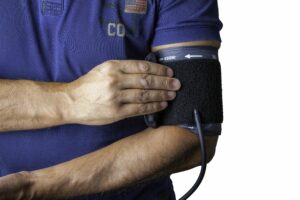 Did you know that cardiology utilizes the power of ultrasound waves to visually monitor heart health? Ultrasound technology is an essential method for catching blood flow irregularities; organ changes; blood clots; and damage in the heart, veins, and other vital organs. Using ultrasound waves (or sonography) and a transducer, a sonographer can see within the patient’s body without painful, invasive means. These images allow your specialist to study the arteries and determine any health concerns. Here are the six types of ultrasound treatments we use at Midwest Cardiovascular Institute and how they can benefit our patients.
Did you know that cardiology utilizes the power of ultrasound waves to visually monitor heart health? Ultrasound technology is an essential method for catching blood flow irregularities; organ changes; blood clots; and damage in the heart, veins, and other vital organs. Using ultrasound waves (or sonography) and a transducer, a sonographer can see within the patient’s body without painful, invasive means. These images allow your specialist to study the arteries and determine any health concerns. Here are the six types of ultrasound treatments we use at Midwest Cardiovascular Institute and how they can benefit our patients.
1. Abdominal Aortic Ultrasound
The aorta transports blood from the heart throughout the rest of your body. High blood pressure, hardened arteries, trauma, and other issues can cause an abdominal aortic aneurysm. This occurs when the aorta becomes enlarged, leading to deep pain in the back or abdomen. An abdominal aorta ultrasound detects aneurysms and blockages in the aorta, near the diaphragm. Your doctor will then determine the best ways to prevent your aneurysm from rupturing. And, depending on the aneurysm’s size, they may recommend surgery.
2. Arterial Ultrasound
Using ultrasound imaging, a sonographer views the arteries in your arms and legs. They will observe the speed of blood flow and search for any blockages in your arteries. Arterial ultrasounds can also identify areas where the arteries are narrowing. If your doctor notices blood clots or damage in your veins, he can assess your condition and determine the best methods of treatment to prevent further damage or health risks.
3. Carotid Ultrasound
Your carotid arteries are located on the sides of your head and neck. These pump blood to your brain. When these arteries become blocked with plaque, patients develop carotid artery disease. This leaves them at greater risk of suffering a stroke. This may occur as a smaller scale stroke called a transient ischemic attack (TIA). Or, a blocked blood vessel may prevent blood flow to the brain, leading to an ischemic stroke. With a carotid duplex ultrasound, your specialist can see blockages in these arteries and then quickly determine a plan of treatment.
4. Echocardiogram
With the use of ultrasound waves, cardiologists can view a picture of the patient’s heart. This helps uncover any structural abnormalities or irregularities in its beating pattern. While the size of one’s heart often correlates with the size of their body, some differentiation in size can occur. For example, an enlarged or thickened heart can indicate hypertrophy. Thanks to this ultrasound imaging, cardiologists can more quickly identify areas of damage.
5. Renal Artery Ultrasound
The renal arteries supply blood and oxygen from the aorta to the kidneys. When this flow is blocked or constricted, the kidneys are unable to receive the necessary nutrients for healthy function. A renal artery ultrasound uses Doppler technology to see through various thicknesses of tissue. This cardiovascular ultrasound allows your physician to notice any signs of renal artery stenosis, or obstruction of the kidneys that prevents proper waste elimination. Or if the renal artery is narrow, the patient is at higher risk of kidney failure or high blood pressure. With detailed imaging, patients can determine the right level of preventative measures or medical intervention needed to protect their kidney health.
6. What is a Venous Ultrasound
In cardiology, this form of ultrasound is used to view how easily blood flows through the veins. Your sonographer will observe any signs of blood clots as well as the direction of blood flow. This is especially effective for diagnosing deep vein thrombosis (DVT) and establishing preventative measures against pulmonary embolism. For patients with varicose veins, a venous ultrasound can help distinguish damaged valves. Or if a patient needs a catheter placed into a vein, this can help to guide the needle.
Schedule an Appointment for a Cardiology Ultrasound Today!
Cardiology uses many forms of advanced technology for patient care, including ultrasound for cardiovascular diagnostic testing. At Midwest Cardiovascular Institute, our physicians are dedicated to providing you with the highest-quality care. And with multiple clinic locations, you can find the closest and most convenient services for your needs. Contact your closest clinic or request an appointment online. Let us help you promote greater heart health, prevent damage and illness, and learn more about how you can live a healthy lifestyle!
Midwest Cardiovascular Institute is hosting a free cardiovascular screening on Thursday, November 4th from 1 p.m. – 6 p.m. at 133 East Brush Hill Road (Suite 202) in Elmhurst.
Guests will receive complimentary electrocardiogram (EKG) and blood pressure screenings. An EKG is a painless test that records the electrical signals of the heart. The screening can detect blockages, the thickness of the heart wall, past heart attacks and more.
Results will be reviewed onsite by MCI cardiologist Dr. Michael Trybula.
Risk factors of vascular disease include family history, high cholesterol, high blood pressure and diabetes, as well as smoking, being overweight or being inactive.
Registration is required. Please visit https://MCIelm2021.eventbrite.com to reserve your spot. Call (985) 873-5058 with any questions.

When plaque builds up inside your arteries, it constricts blood flow. This limits oxygen from traveling to the heart. These blockages are a sign of heart disease, the number one cause of death of men and women in the United States. This is why early screenings are essential for heart disease prevention. Midwest Cardiovascular Institute helps you understand, avoid, and control the risks of cardiovascular disease. This way, you can maintain a long, happy life.
Why Are Early Screenings Important?
Screening your heart health allows physicians to detect the earliest signs of cardiovascular disease. This is when it is most treatable. You will first undergo a screening to catch any risk factors that may not appear on the surface. This typically consists of a blood test. If your results show signs of heart disease risk, your physician may seek additional screening. Your testing may include but not be limited to the following:
- Blood tests measure cholesterol, blood pressure, and blood sugar levels. This is used for your initial screening.
- Echocardiography allows cardiologists to view your heart’s movement with ultrasound.
- Electrocardiography monitors the heart’s electrical activity to study its rhythm and rate.
- Cardiac stress tests utilize exercise to measure blood flow during stress. You may walk on a treadmill or ride a stationary bike through varying intensity levels.
Prevention is key to longevity, whether or not you are presenting symptoms or risk factors. The American Heart Association (AHA) states that cardiovascular screening can begin as early as age 20. Even if your screenings do not indicate that you are a high-risk patient, your results can act as an incentive to lead or continue a healthy lifestyle. Ready to take the first steps in heart disease prevention? Connect with one of our highly-trained cardiologists! New and returning patients can request an appointment today.
Know the Risk Factors of Heart Disease
You now know that heart screenings are essential even without current signs for worry. But knowing your risk factors is still vital to your health. There are risk factors that can and cannot be changed. Examples of factors outside our control are race, age, and gender. Males, patients 65 years of age and older, and African-Americans are at the highest risk of developing heart disease. Risk factors for heart disease that can be modified include:
- High body mass index (BMI)
- High blood sugar and cholesterol
- Smoking and drinking alcohol
- Low levels of physical activity
- And your dietary habits
Consult with your cardiologist to learn if you are at risk of cardiovascular disease. Your physician will explore your lifestyle choices, family history, and current state of health. If you show signs of risk, your physician can offer you solutions for prevention. This can include medication, heart stents, or altering your diet and physical activity.
Find More Tools For Heart Disease Prevention
With knowledge of heart disease risks and regular visits to your cardiologist, you can stay on top of heart disease prevention! Whether or not you are presenting symptoms of cardiovascular disease, you should continue consistent check-ups. This will offer peace of mind or help to catch any dangerous symptoms early on. At Midwest Cardiovascular Institute, you can find expert care with internationally-recognized physicians. Are you ready to make your heart healthy and disease prevention a priority? Call your nearest clinic or request an appointment with us today. We look forward to sharing the care and compassion you deserve!

Your heart health matters. According to the World Health Organization, heart disease has been the leading cause of death worldwide for 20 years. In the United States alone, this accounts for an estimated 655,000 deaths a year. Risk factors for developing heart disease range from genetic history to the influence of personal lifestyle habits. At Midwest Cardiovascular Institute, we want you to know the risks to stay on top of your heart health. Learn how you can control your risk of heart disease.
Risk Factors Of Heart Disease
For some, heart disease is hereditary. Risk factors such as family history, age and sex are out of your control. However, many risk factors can be controlled to greatly lessen your risk. These include:
Risk Factors You Can Control
- Tobacco use/smoking
- High blood cholesterol
- High blood pressure
- Physical inactivity
- Obesity
- Diabetes
- Diet and nutrition
- Stress
The above risk factors can be modified and influenced by your lifestyle and daily choices. Let’s break down a few of these below.
Weight
Overweight or obese individuals are at a high risk of developing heart disease and type 2 diabetes. This can also lead to high blood pressure and a greater risk of stroke. Weight loss and healthy nutrition are key to lowering BMI taking excess pressure off of the body and your internal organs. Exercise regularly, eat balanced meals of lean protein and vegetables, regulate your portion sizes, and drink plenty of water. Putting your health first is imperative to a healthy heart.
High Blood Pressure & Cholesterol + Diet
Your cholesterol and blood pressure levels greatly affect your cardiovascular health. Cholesterol references the levels of fatty substances in your blood. Blood pressure indicates the amount of exertion blood cells place on the walls of your arteries. If these levels are too high, this can make it much harder to pump blood through the body. For healthier levels, avoid foods with high amounts of salts and saturated fat. Make physical activity an important part of your daily routine.
Alcohol & Tobacco
Not all enjoyable things are good for you. For example, smoking and drinking alcohol can double your risk of heart attack and disease. Alcohol introduces excess calories into your system and contributes to weight gain. Smoking cigarettes and alcohol consumption also place extra stress on the body by raising blood pressure and cholesterol levels. Limit your alcoholic beverages to no more than one a day, and look for solutions to cut out smoking altogether.

May 9th marks the beginning of National Women’s Health Week, and it’s a great opportunity to explore concerns and misconceptions surrounding heart disease in women. While several campaigns have been successful in raising awareness about the dangers and prevention of heart disease, many people still consider it to be an issue that almost exclusively affects men.
However, women represent nearly half of all heart-disease-related deaths. According to the CDC, only 56% of women recognize heart disease as the leading cause of death for their gender. Stroke and heart disease are responsible for approximately one in every three deaths among women each year. But this doesn’t have to be the case. Nearly 80% of stroke and cardiac events can be prevented through education, informed choices, and better living. Learn how heart disease impacts women as well as how you can better protect yourself and your loved ones.
Signs of a Heart Attack Can Differ Between Women and Men
Men and women can experience similar warning signs prior to a heart attack. These can include shortness of breath, chest pains, and pain in the upper body. However, women are more likely to experience less pronounced symptoms, such as:
- Shortness of breath
- Pain in the jaw, shoulder, upper back, or neck
- Fatigue
- Sweating
- Nausea, indigestion, or vomiting
- Lightheadedness
Understanding these signs is an important part of keeping yourself protected. It can also be beneficial to share this information with friends and family to help spread awareness.
Certain Risk Factors Impact Women Differently Than Men
Did you know that heart disease risk factors in women can be different as well? In fact, there are some risk factors that are exclusive to women. For example, when estrogen levels drop during menopause, it can have a negative impact on the blood vessels. Pregnancy can also increase a woman’s long-term risk for heart disease when combined with conditions such as diabetes or high blood pressure. Additionally, several conditions that can increase the risk of both sexes tend to have a greater impact on women. These include inactivity, smoking, inflammatory diseases, depression, stress, and a family history of heart disease.
Take a Stand Against Heart Disease in Women
Understanding how heart disease impacts women is the first step toward raising awareness and increasing prevention. Many women may focus on taking care of the needs of others while neglecting their own health. But your heart health is important, and you should prioritize it, giving it the care and attention it deserves. Consider scheduling an appointment with Midwest Cardiovascular Institute for a cardiovascular screening. Let’s all take a stand against women’s heart disease and work toward a brighter, healthier future for everyone.